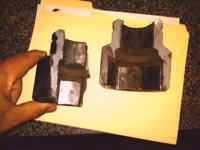Beware Exploding Sockets
 Beware Exploding Sockets
Beware Exploding Sockets
Hytorc® bolting heads have long been regarded as a safer alternative to hammering on a striking wrench to remove stubborn case bolts. But even impact sockets can shatter under extreme Hytorc® pressures, sending shrapnel rocketing across the turbine deck. These explosive failures can cause serious injury or even death.
These failures can be reduced, but not eliminated, by using the correct socket. Impact rated sockets must be used at a minimum. Old or worn sockets are of particular concern. Ill-fitting sockets do not fit tight on bolt heads. This changes the stress points from the corners to the flats of the sockets and causes them to fail. Best practice is to inspect sockets regularly and color code or otherwise identify them for this use. Another check for reliability would be to have the sockets inspected for potential indications of stress using NDE methods. Hytorc® makes their own sockets and this may give an extra level of confidence. However, in their safety note, Hytorc® only prohibits the use of altered, heavily used, damaged or chrome sockets.
Any socket can fail, so take steps to mitigate the result. If possible, shroud the socket with a piece of pipe cut slightly bigger than the diameter of the socket and same height. If the socket fails, the pipe will hold everything inside. TGM is currently investigating a fiber impregnated tape designed to contain the debris. We also recommend tying off the head to prevent it dropping or flying off after a failure.
Be aware of your hydraulic forces. Sockets are prone to failure when torqued more than twice the specified amount for assembly. Backup wrenches may not be rated for the torque applied. Limit torque to the capacity of the weakest tool in the application. Hytorc® publishes charts on their website which convert pump pressure to torque applied for each of their tools.
Finally, protect your personnel. No one is to be in contact with the head or backup wrenches after initial clamping pressure is applied and until pressure is released. Determine the potential debris path and keep personnel away from the area. You can also use a piece of plywood or metal as a shield. Face shielding is recommended as PPE for all personnel near the danger zone.
Remember that Hytorc® equipment is dangerous and must only be operated by trained individuals. Best practice is to have the same person operate both the tool head and the pump. When this is not possible, the pump operator must be in sight of the tool operator. Three way communication must be used between them.
